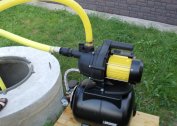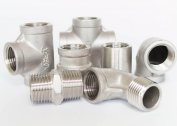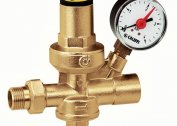In many private areas, and sometimes even several whole villages, an underground well decides to supply water. A well is drilled deep into the earth and, if there is an underground source of water, pumps it out for human needs. Such an underground source can work for about 5 to 50 years, depending on the depth of the well and the source itself, how much it is rich in groundwater. There are several classifications and subspecies of wells, and they also have different purposes. Depending on the goals of the well, a method of drilling wells is chosen. The most important thing is to remember that all work is best done with professional equipment and hire specialists. We will talk about this in this article.
What classification of wells can be
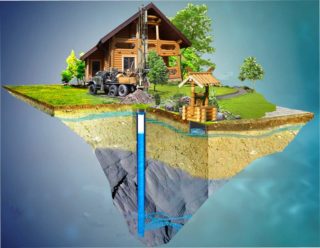 Surveyors divide several types of wells on the site, their classification depends on the depth, purpose and width of the dug well. There are types:
Surveyors divide several types of wells on the site, their classification depends on the depth, purpose and width of the dug well. There are types:
- Exploratory.
- Filter
- Artesian.
- Industrial wells.
Special equipment is used for drilling wells and boreholes, it can only differ in width and depth, and the principle of operation is the same everywhere, regardless of the subspecies.
In order to check the availability of a water source, it is necessary to first conduct test drilling. It also has its own types and depends on the initial availability of soil. Drilling a well is not a cheap business, so you should approach with all care so as not to spend extra money. To do this, you must correctly select one of the types of checks: rotational, core, snack.
The first method is the cheapest and most profitable for verification, it does not imply the presence of complex expensive equipment, but if you could not find a source of water at a high level, you should apply the second two methods of verification, they will allow you to find the depth of groundwater at a lower distance from the surface.
Therefore, before proceeding and choosing which type of well you will need to drill, you should determine the type of well, and then understand which type of drilling is suitable for it.
Chart well
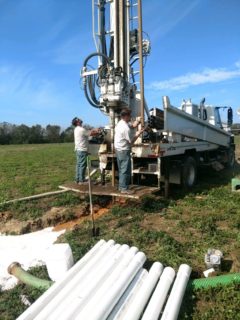 Mapping wells are needed to determine the bedding pattern of layers composed of bedrock, usually such wells are drilled to a depth of 20 to 300 m.The purpose of such drilling is to study and analyze groundwater, and also determine the level of complexity and power of installing pumps for pumping water.
Mapping wells are needed to determine the bedding pattern of layers composed of bedrock, usually such wells are drilled to a depth of 20 to 300 m.The purpose of such drilling is to study and analyze groundwater, and also determine the level of complexity and power of installing pumps for pumping water.
Mostly, light alloy pipes are used for drilling, if these are not deep wells, then up to 24 mm, for deep drilling pipes with diameters from 150 to 200 m. This type of well is also called search and mapping, as it is drilled at the stage of surveying in order to identify the geological and hydrogeological structure of the site and the prospect for future drilling. Another head distinguishing feature can be called the fact that this method is chosen when drilling unstable rocks.
Exploratory
In exploratory wells, partial or complete core sampling is performed. Kern, as it is called a rock sample, which is designed for a specific type of drilling. Exploratory drilling is distinguished by a large pipe diameter, since the need for research is being pursued, and the larger the area, the more accurate the determination of the aquifer. If, according to the results of the study, the purpose of the well will be exploration and production, then at the end of the pipe there is a pump for pumping water.
Artesian
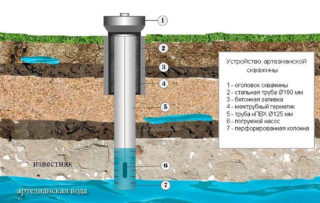 Artesian wells are attributed to the extraction of mineral waters, the depth of the wells can reach from 50 to 200 meters.It is at such a depth that underground sources are saturated with useful minerals. The productivity of an artesian well can reach 3-4m3 / hour, which can provide several residential quarters or a small town with real mineral water. The drilling time of an artesian well can reach from three to twelve days, it depends on the limestone layers of the soil where the water flows. Steel pipes provide water flow through the well. Casing pipes are achieved with a diameter of 219 to 425 mm. The duration of the non-decreasing productivity of an artesian well can reach 50-60 years.
Artesian wells are attributed to the extraction of mineral waters, the depth of the wells can reach from 50 to 200 meters.It is at such a depth that underground sources are saturated with useful minerals. The productivity of an artesian well can reach 3-4m3 / hour, which can provide several residential quarters or a small town with real mineral water. The drilling time of an artesian well can reach from three to twelve days, it depends on the limestone layers of the soil where the water flows. Steel pipes provide water flow through the well. Casing pipes are achieved with a diameter of 219 to 425 mm. The duration of the non-decreasing productivity of an artesian well can reach 50-60 years.
Well on the sand
A sand well is the simplest type of well. At the bottom is an additional sand filter. Drilling of such wells continues until water is produced from sandy soil up to one meter cubic per hour. The depth of drilling sand wells is small, it reaches from fifteen to thirty-five meters depth. Its operation with proper construction and drilling can reach a year.
Water from such wells can be drinking water, and not just irrigation or industrial purposes, unless of course you put an additional filter and clean it before use. The whole process of drilling for water is not as simple as it seems, drilling takes quite a long time and a lot of effort. Be sure to contact the professionals, people who understand this and will be able to drill a well with quality. Also, determining the location of drilling and finding water is not as simple as it seems, you can’t just select a site by eye and start digging. In addition to the process of extracting water, the sand filter itself plays an important role, which allows to improve the flow and the life of the well.
Industrial
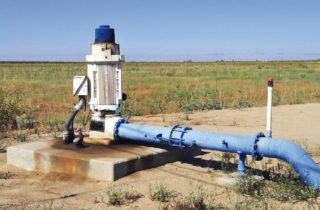 The main distinguishing feature of industrial wells is that before the start of drilling, it is necessary to collect many special permits. Industrial wells relate to the qualification of wells with complex drilling processes and wells. The depth level of such a well is not inferior to the depth of an artesian well.
The main distinguishing feature of industrial wells is that before the start of drilling, it is necessary to collect many special permits. Industrial wells relate to the qualification of wells with complex drilling processes and wells. The depth level of such a well is not inferior to the depth of an artesian well.
Only unlike artesian wells, industrial drilling is considered and is more difficult, because it uses sophisticated industrial equipment and special pipes with a cross section of at least 219 mm. Wells for industrial purposes are designed to provide water to large enterprises, cities and agricultural production. Production wells produce from 100 m3 / hour.
Perfect well
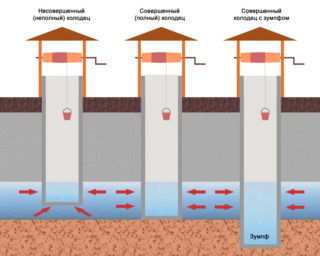 If on the site it is known that the thickness of the aquifer is not large, then it is better to choose a perfect well as a feature of choosing the type of well, otherwise it is also called perfect with a sump. Sometimes when digging a well, some workers, not knowing the specifics of a perfect well, build imperfect. This is expressed in digging deep, although sometimes it can be built in such a way that even a weak pressure would suffice for all needs. If you dig deep, then the water rests on the aquifer and the flow comes from the surface, which is not very good.
If on the site it is known that the thickness of the aquifer is not large, then it is better to choose a perfect well as a feature of choosing the type of well, otherwise it is also called perfect with a sump. Sometimes when digging a well, some workers, not knowing the specifics of a perfect well, build imperfect. This is expressed in digging deep, although sometimes it can be built in such a way that even a weak pressure would suffice for all needs. If you dig deep, then the water rests on the aquifer and the flow comes from the surface, which is not very good.
The best option is to make a perfect well. Its bottom should be at the level of the aquifer, which guarantees drying out only if the aquifer itself is depleted and dry. There is only seasonal influence, but it is also uncritical. The shaft of such a well can pass through, and only be 1-2 rings in the recess. Accordingly, a recess is created that makes a buffer tank where water accumulates. In this way, the bottom of a perfect well sinks lower, and the water itself and the column of water are larger. For a private plot, this is an ideal building option.
Manhole
The manhole is made of precast concrete or brick on the water supply network. In most private houses that are located in the villages, they are usually connected to the central water supply.But some additionally, at the border of the site, they cut a highway, a pipe that passes to a residential building. The central water supply is always buried in the ground, and for insertion, a recess is built in the form of a well from which it takes water to the house. A crane is mounted in place, and a water meter is installed. In fact, the owners themselves are not looking for groundwater, but take it directly from the central water supply.
Before drilling wells, it is necessary to organize and consult with professionals, it is necessary to take into account the communication schemes for the drilling site, and take into account the level of the slope of the earth's surface. Of course, in order to determine what type of wells you need to drill, you need to know why and in what quantities water will be consumed. If for local use and provided that there is centralized water, it is better to choose a viewing well. To provide the village with underground water, of course, a permit is taken for the construction of industrial wells.
